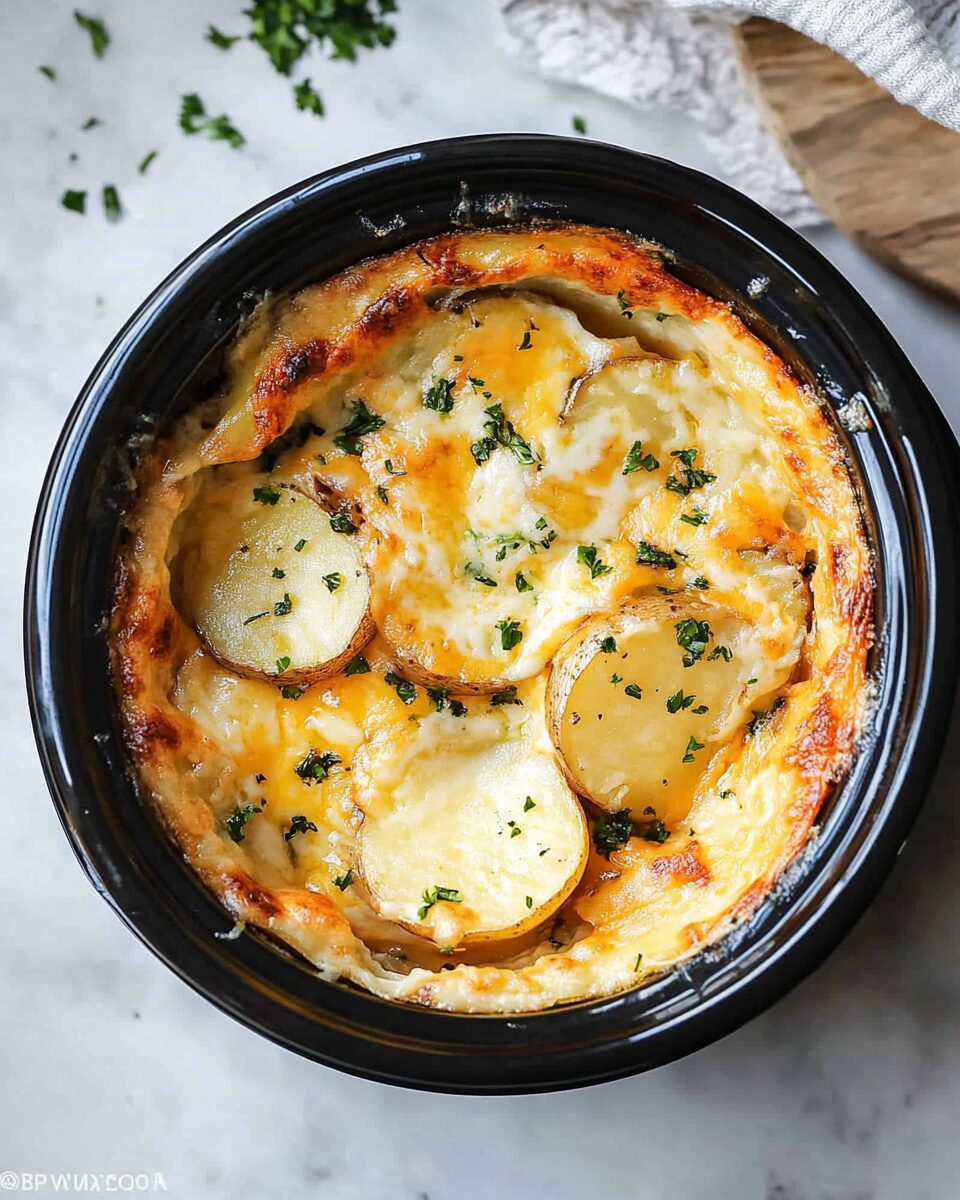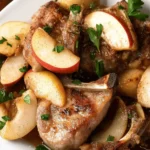The aroma of creamy cheese sauce bubbling away in the slow cooker is a surefire way to get mouths watering long before dinner time. These Crock Pot Cheesy Scalloped Potatoes are the ultimate side dish comfort food — rich, decadent, and effortlessly prepared. Whether you’re hosting a holiday feast, preparing a family dinner, or simply want to upgrade your side dish game, this recipe delivers every time. With layers of tender potatoes smothered in a savory, melty cheese sauce, this classic dish made easy in a slow cooker brings both simplicity and irresistible flavor to your table.
Full recipe:
Ingredients:
-
6 medium russet potatoes, peeled and thinly sliced
-
1 small onion, finely chopped
-
2 tablespoons unsalted butter
-
2 tablespoons all-purpose flour
-
1 ½ cups milk
-
2 cups shredded sharp cheddar cheese
-
½ teaspoon garlic powder
-
½ teaspoon paprika
-
Salt and pepper to taste
-
Chopped fresh parsley for garnish (optional)
Directions:
-
In a saucepan over medium heat, melt butter. Whisk in the flour and cook for about 1 minute until bubbling.
-
Gradually whisk in the milk and cook until the sauce thickens, about 3-4 minutes.
-
Stir in the garlic powder, paprika, salt, pepper, and 1 ½ cups of shredded cheese until melted and smooth.
-
Spray the inside of your crock pot with non-stick spray.
-
Layer half of the sliced potatoes on the bottom, followed by half the chopped onion and half of the cheese sauce. Repeat with remaining potatoes, onions, and sauce.
-
Cover and cook on low for 6-7 hours or on high for 3-4 hours, until the potatoes are tender.
-
In the last 30 minutes of cooking, sprinkle the remaining ½ cup cheese over the top and cover until melted.
-
Garnish with chopped parsley if desired before serving.
Prep Time: 20 minutes | Cooking Time: 6 hours | Total Time: 6 hours 20 minutes
Kcal: 320 kcal | Servings: 6 servings
The History of Scalloped Potatoes
Scalloped potatoes, often associated with cozy Sunday dinners and holiday tables, have roots in European cuisine—particularly French and English. The term “scalloped” is believed to come from the Old English word “collop,” which referred to slices of meat or food. Traditionally, scalloped potatoes consist of thinly sliced potatoes baked in a creamy sauce, often with a crunchy topping or cheese. Over time, this humble dish evolved, especially in the United States, where the addition of cheese transformed it into a rich, comforting staple.
The use of the slow cooker or crock pot is a modern adaptation that embraces convenience while preserving the dish’s creamy integrity. It allows the potatoes to slowly absorb the flavors of cheese, butter, and spices, resulting in a dish that’s both nostalgic and perfectly suited to today’s fast-paced kitchens.
Why This Slow Cooker Version is the Best
What sets this particular Crock Pot Cheesy Scalloped Potatoes recipe apart is the use of a homemade cheese sauce crafted from butter, flour, milk, and freshly shredded cheddar. Unlike some recipes that rely on processed cheese or canned soups, this version offers a scratch-made base that’s both flavorful and wholesome.
The slow cooker method ensures even cooking, preventing the edges from drying out or the center from being undercooked. The result? Potatoes that are tender throughout, enveloped in a silky, melty cheese sauce. Plus, by preparing this dish in the slow cooker, you free up valuable oven space—an invaluable advantage during busy holiday cooking or family dinners.
Nutritional Benefits and Comforting Qualities
While scalloped potatoes are undoubtedly a comfort food, this recipe includes some notable benefits. Potatoes are an excellent source of potassium, vitamin C, and fiber when the skin is included (though this version uses peeled potatoes for texture consistency). Using sharp cheddar cheese provides a rich source of calcium and protein, which helps balance out the carbohydrates from the potatoes.
Homemade versions of cheesy potato dishes like this allow you to control the ingredients, reduce preservatives, and cut back on sodium by seasoning to taste rather than relying on store-bought mixes.
Moreover, the warmth, aroma, and creamy texture of this dish are proven mood boosters. Comfort food has psychological benefits—especially dishes with nostalgic connections to family meals, traditions, and celebrations.
Occasions to Serve Cheesy Scalloped Potatoes
Crock Pot Cheesy Scalloped Potatoes are incredibly versatile. They can be served as a holiday side dish, a potluck favorite, or a cozy winter warmer. They’re hearty enough to pair with everything from roast meats and baked ham to vegetarian entrees like roasted cauliflower steaks or lentil loaf.
This recipe is particularly beloved during:
- Thanksgiving and Christmas
- Easter brunches
- Sunday family dinners
- Potlucks and gatherings
- Cold-weather comfort meals
They also make excellent leftovers—just reheat gently and enjoy all over again.
Tips for Perfect Scalloped Potatoes Every Time
- Use a mandoline for slicing: Ensuring even slices helps the potatoes cook uniformly and absorb the sauce more consistently.
- Shred your own cheese: Pre-shredded cheese contains anti-caking agents that can impact the smoothness of the sauce. Freshly shredded cheese melts more evenly and tastes better.
- Layer with purpose: Keep the layering structured—potatoes, onions, sauce—to ensure every bite gets a bit of everything.
- Don’t rush the cook time: Low and slow is key to tender, flavorful results.
Customizations and Variations
While the classic version is divine as is, you can also put your own spin on the recipe:
- Add diced ham or bacon for a meaty twist.
- Use Gruyère or Monterey Jack in place of cheddar for a different cheese profile.
- Include herbs like thyme or rosemary for added depth.
- Make it spicy with a pinch of cayenne or chopped jalapeños.
- Add a crispy topping in the last hour—think buttered breadcrumbs or crushed crackers.
These modifications not only keep the dish exciting but allow you to cater to different preferences and dietary needs.
Pairing Suggestions
The creamy, cheesy richness of scalloped potatoes pairs beautifully with a variety of main dishes. Here are a few ideas:
- Herb-Crusted Roast Beef
- Honey-Glazed Ham
- Baked Tofu Steaks
- Grilled Mushrooms or Portobello Caps
- Roasted Turkey or Chicken
Pair it with a crisp green salad or roasted Brussels sprouts to add some balance to the plate.
Storage and Reheating Tips
This dish stores well in the refrigerator for up to 4 days. To reheat, simply cover and warm in a 300°F oven for 20 minutes, or microwave individual portions. The sauce may thicken further as it sits, but adding a splash of milk or cream before reheating can restore its creamy texture.
You can also freeze leftovers, although the texture of the potatoes may slightly change upon thawing. Freeze in airtight containers and reheat thoroughly.
Why You’ll Keep Coming Back to This Recipe
At the heart of this Crock Pot Cheesy Scalloped Potatoes recipe is a perfect balance of convenience and indulgence. It’s the kind of dish that brings people together around the table, prompts seconds (and thirds), and gets requested again and again.
Whether you’re hosting a crowd or feeding a hungry family, this recipe guarantees satisfaction. It’s budget-friendly, requires minimal prep, and delivers maximum flavor. Once you try this homemade, slow-cooked version, it’s likely you’ll never go back to boxed mixes or oven-baked shortcuts.
Conclusion
Crock Pot Cheesy Scalloped Potatoes are more than just a side dish—they’re a nostalgic, soul-satisfying culinary experience. They prove that comfort food doesn’t have to be complicated and that traditional recipes can evolve with modern tools like the slow cooker to become even more approachable. So next time you’re looking to elevate your dinner table with something creamy, cheesy, and universally loved, reach for your slow cooker and give this dish a place of honor. You won’t be disappointed. Would you like help expanding this article further or optimizing it for SEO?






